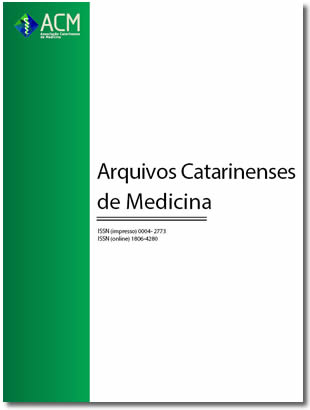PERFIL EPIDEMIOLÓGICO DE PACIENTES COM NÓDULOS PULMONARES EM ACOMPANHAMENTO AMBULATORIAL NO PERÍODO DE 2013 A 2015
Keywords:
Nódulo pulmonar solitário, TC de tórax, Câncer de pulmão.Abstract
Este artigo teve como objetivo conhecer o perfil epidemiológico dos pacientes com nódulos pulmonares descobertos de forma acidental e seu desfecho durante o acompanhamento no ambulatório de pneumologia de Criciúma/SC entre os anos de 2013 a 2015. Realizou-se um estudo observacional, longitudinal, retrospectivo, de abordagem quantitativa, com coleta de dados de 250 prontuários de pacientes com diagnóstico de nódulo pulmonar ao acaso. As características clínicas estudadas foram: gênero, idade, tabagismo, carga tabágica e o exame de diagnóstico. As características radiográficas avaliadas em relação ao nódulo foram: presença de margens espiculadas, tamanho nodular, localização anatômica e, posteriormente, os nódulos foram classificados em: provavelmente benigno, maligno ou indeterminado. Como resultado, percebeu-se que 58,8%dos casos de nódulo pulmonar foram observados em mulheres, sendo a faixa etária mais comum, independente de gênero, entre 51-70 anos. Em 60,6% dos pacientes, o raio-X de tórax foi o exame que detectou esses nódulos. Observou-se, também, que 60,8% dos nódulos foram classificados como provavelmente benigno e 44,8% dos nódulos localizaram-se em lobos superiores. Houve associação significativa entre malignidade do nódulo e tamanho do mesmo (p = 0,001).Portanto, conclui-se que a prevalência dos nódulos incidentais foi maior na faixa etária de 51-70 anos, sendo que as mulheres alcançaram porcentagem 17,6% superior ao sexo masculino. Verificou-se predomínio da distribuição dos nódulos em lobos superiores e da categorização dos nódulos como provavelmente benignos. Além disso, significância estatística foi constatada em relação aos maiores tamanhos nodulares e provável desfecho maligno (p = 0,001).References
Barjaktarevic I, Grimes B, Ruchalski K, Aberle D, Arenberg D. Indeterminate Pulmonary Nodules: How to Minimize Harm. Seminars in Respiratory and Critical Care Medicine. 2016;37(05):689-707.
Hansell D, Bankier A, MacMahon H, McLoud T, Müller N, Remy J. Fleischner Society: Glossary of Terms for Thoracic Imaging. Radiology. 2008; 246(3):697-722
Mosmann M, Borba M, Macedo F, Liguori A, Villarim Neto A, Lima K. Solitary pulmonary nodule and 18F-FDG PET/CT. Part 1: epidemiology, morphological evaluation and câncer probability. Radiologia Brasileira. 2016;49(1):35-42.
Rossato Silva D, Tadeu Baglio P, Basso Gazzana M. Nódulo Pulmonar Solitário. Revista Brasileira de ClínicaMédica.2009;1(7):132-139.
Mohamed Hoesein F, Bülbül M, de Jong P. Pulmonary nodule follow-up: be careful with volumetry between contrast enhanced and unenhanced CT. Annals of Translational Medicine. 2016;4(18):346-346.
Kikano G, Fabien A, Schilz R. Evaluation of the Solitary Pulmonary Nodule. American Family Physician. 2015;92(12):1084-1091.
Gould M, Donington J, Lynch W, Mazzone P, Midthun D, Naidich D et al. Evaluation of Individuals With Pulmonary Nodules: When Is It Lung Cancer?. Chest. 2013;143(5):e93S-e120S.
Al Mohammad B, Brennan P, Mello-Thoms C. A review of lung cancer screening and the role of computer-aided detection. Clinical Radiology. 2017;72(6):433-442
Albert R, Russell J. Evaluation of the Solitaty Pulmonary Nodule. American Family Physician. 2009;80(8):827-831.
Gould M, Sanders G, Barnett P, Rydzak C, Maclean C, McClellan M et al. Cost-Effectiveness of Alternative Management Strategies for Patients with Solitary Pulmonary Nodules. Annals of Internal Medicine. 2003;138(9):724-735.
Wahidi M, Govert J, Goudar R, Gould M, McCrory D. Evidence for the Treatment of Patients With Pulmonary Nodules: When Is It Lung Cancer?. Chest. 2007;132(3):94S-107S.
Danforth K, Early M, Ngan S, Kosco A, Zheng C, Gould M. Automated Identification of Patients With Pulmonary Nodules in an Integrated Health System Using Administrative Health Plan Data, Radiology Reports, and Natural Language Processing. Journal of Thoracic Oncology. 2012;7(8):1257-1262.
Gould M, Tang T, Liu I, Lee J, Zheng C, Danforth K et al. Recent Trends in the Identification of Incidental Pulmonary Nodules. American Journal of Respiratory and Critical Care Medicine. 2015;192(10):1208-1214.
Gierada D, Pinsky P, Nath H, Chiles C, Duan F, Aberle D. Projected Outcomes Using Different Nodule Sizes to Define a Positive CT Lung Cancer Screening Examination. JNCI Journal of the National Cancer Institute. 2014;106(11):dju284-dju284.
Marchiori E, Irion K. Avanços no diagnóstico radiológico dos nódulos pulmonares. Jornal Brasileiro de Pneumologia. 2008;34(1):2-3.
MacMahon H, Austin J, Gamsu G, Herold C, Jett J, Naidich D et al. Guidelines for Management of Small Pulmonary Nodules Detected on CT Scans: A Statement from the Fleischner Society. Radiology. 2005;237(2):395-400.
Holin S, Dwork R, Glaser S, Rikli A, Stocklen J. Solitary pulmonary nodules found in a community-wide chest roentgenographic survey. American Review of Tuberculosis. 1959;79(4):427-439.
Reduced Lung-Cancer Mortality with Low-Dose Computed Tomographic Screening. New England Journal of Medicine. 2011;365(5):395-409. National Lung Screening Trial Research Team
Qureshi N, Rintoul R, Miles K, George S, Harris S, Madden J et al. Accuracy and cost-effectiveness of dynamic contrast-enhanced CT in the characterisation of solitary pulmonary nodules—the SPUtNIk study. BMJ Open Respiratory Research. 2016;3(1):e000156.
Gould M. Evaluation of screening-detected lung nodules: minimising the risk of unnecessary biopsy and surgery. Thorax. 2011;66(4):277-279.
McWilliams A, Tammemagi M, Mayo J, Roberts H, Liu G, Soghrati K et al. Probability of Cancer in Pulmonary Nodules Detected on First Screening CT. New England Journal of Medicine. 2013;369(10):910-919.
MacMahon H, Naidich D, Goo J, Lee K, Leung A, Mayo J et al. Guidelines for Management of Incidental Pulmonary Nodules Detected on CT Images: From the Fleischner Society 2017. Radiology. 2017;284(1):228-243.
Talwar A, Rahman N, Kadir T, Pickup L, Gleeson F. A retrospective validation study of three models to estimate the probability of malignancy in patients with small pulmonary nodules from a tertiary oncology follow-up centre. Clinical Radiology. 2017;72(2):177.e1-177.e8.
Yang L, Zhang Q, Bai L, Li T, He C, Ma Q et al. Assessment of the cancer risk factors of solitary pulmonary nodules. Oncotarget. 2017;8(17):29318-29327
Horeweg N, van der Aalst C, Thunnissen E, Nackaerts K, Weenink C, Groen H et al. Characteristics of Lung Cancers Detected by Computer Tomography Screening in the Randomized NELSON Trial. American Journal of Respiratory and Critical Care Medicine.2013;187(8):848-854.
Downloads
Published
Issue
Section
License
Copyright (c) 2018 Arquivos Catarinenses de Medicina

This work is licensed under a Creative Commons Attribution-NonCommercial-ShareAlike 4.0 International License.
Este trabalho está licenciado sob uma licença Creative Commons Attribution-NonCommercial-ShareAlike 4.0 International License.

